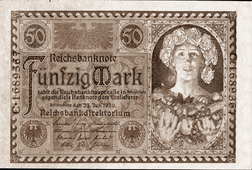Weisenburger Mark: Difference between revisions
From MicrasWiki
Jump to navigationJump to search
No edit summary |
mNo edit summary |
||
| Line 4: | Line 4: | ||
| image_title_1 = A 𝔐 50 note issued in {{AN|1725}} | | image_title_1 = A 𝔐 50 note issued in {{AN|1725}} | ||
| alt1 = | | alt1 = | ||
| mos_code = | | mos_code = UPM | ||
| issuing_authority = Weisenburger Reichsbank | | issuing_authority = Weisenburger Reichsbank | ||
| superunit = | | superunit = | ||
Revision as of 17:35, 23 November 2023
| Weisenburger Mark | |
 A 𝔐 50 note issued in 1725 AN | |
| MOS–4 | |
|---|---|
| Code | UPM |
| Denominations | |
| Subunit | |
| 1⁄100 | Pfenning (₰) |
| Symbol | 𝔐 |
| Nickname | Papiere |
| Banknotes | |
| Freq. used | 𝔐 1, 𝔐 5, 𝔐 10, 𝔐 20, 𝔐 50, 𝔐 100, 𝔐 500 |
| Rarely used | 𝔐 1,000, 𝔐 5,000 (accounting use only) |
| Coins | |
| Freq. used | 1₰, 5₰, 10₰, 25₰, 50₰, 𝔐 1 |
| Rarely used | 𝔐 5, 𝔐 10, 𝔐 20 (accounting use only) |
| Demographics | |
| User(s) |
|
| Issuance | |
| Central bank | Weisenburger Reichsbank |
| Pegged with | 𝔐 5.05 = ₢ 1 |
The Weisenburger Mark is the official currency of the United Principalities of Cibola. It is managed by the Weisenburger Reichsbank who mints, distributes, and dictates the currency's policy.
The Mark was introduced in 1725 AN to replaced the many regional currencies and barter systems used in the area. There was early proposals by the Imperial Senate to revive the use of Ludwigspfennig, however due to the currencies growing loss of value since the collapse of Sankt Ludwigshafen and the Lanzerwald, this plan was abandoned.